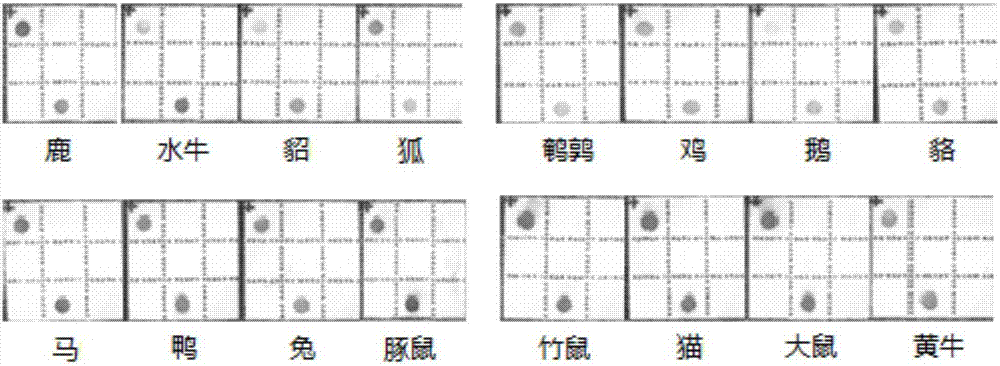Kit for detection of animal origin components and detection method
A kit and animal-sourced technology, applied in biochemical equipment and methods, microbiological determination/inspection, etc., can solve the problems of high detection cost and achieve the effects of improved detection sensitivity, high degree of visualization, and strong specificity
- Summary
- Abstract
- Description
- Claims
- Application Information
AI Technical Summary
Problems solved by technology
Method used
Image
Examples
Embodiment 1
[0036] Example 1 Preparation of kit
[0037] 1.1 Preparation of membrane chip
[0038] The five probes of pig, sheep, yak, donkey, and mouse as shown in Seq No. 1-8 as well as positive probe, negative probe and internal reference probe are prepared into a solution with a concentration of 25 μmol / L with ultrapure water , Using a micro-quantitative spray-point membrane chip spotting instrument to distribute each nucleotide probe in a specific location area on the negatively charged nylon membrane chip. The layout of the probes coated on the chip surface is as follows figure 1 As shown, PC is a positive probe and NC is a negative probe.
[0039] 1.2 Reagent preparation
[0040] Prepare 10×PCR buffer (P1), containing 15 mmol / L MgCl 2 , 100 mmol / L Tris-HCl, 500 mmol / L KCl, and its pH is 8.3.
[0041] Prepare the multiple PCR primer master mix (P2) with the amplification primer pairs of pig, sheep, yak, donkey, and mouse as shown in Seq No. 10-21 and the internal reference amplification prim...
Embodiment 2
[0049] Example 2 Determination of the specificity and sensitivity of the kit for detecting 5 kinds of animal-derived components
[0050] 2.1 Extraction and purification of DNA in the experiment
[0051] After pre-processing the samples containing pig, sheep, donkey, yak, and mouse components, extract and purify DNA, and use a nucleic acid protein analyzer to detect its concentration and quality OD 260 / OD 280 When the value is between 1.7-1.9, it is used for multiplex PCR amplification. The DNA extracted from the corresponding animal-derived species was used as a positive control, the DNA of a species known to be free of the animal-derived species was used as a negative control, and sterilized water was used as a blank control.
[0052] 2.2 Multiplex PCR
[0053] Use the DNA obtained in 2.1 as a template to perform multiplex PCR. The system is shown in Table 1, and the reaction parameters are as follows to obtain the amplified product:
[0054] Firstly, it is denatured at 95°C for 10 m...
Embodiment 3
[0073] Example 3 Test kit for detecting ingredients in meat products
[0074] Collect 173 market samples from sources such as farmers’ markets, supermarkets, and the Internet. The sample types include fresh meat, meat skewers, meatballs, pre-made meat, jerky, ham sausage, etc. The methods described in 2.1-2.4 The samples were tested, and the results are shown in Table 3.
[0075] Table 3 Test results of animal-derived components of samples
[0076]
[0077] It was found that the test results of fresh meat samples had a relatively high compliance rate with their labels, about 85%, and there were frauds in yak meat, donkey meat, and mutton; 10 meat skewers with labels only labeled with sheep ingredients were all detected. However, 2 samples were detected with pig ingredients, and the test results were 80% in compliance with their labels; 17 meatball samples were labeled with animal-derived ingredients such as chicken, pig, sheep, and duck. Porcine-derived ingredients were found, of w...
PUM
 Login to View More
Login to View More Abstract
Description
Claims
Application Information
 Login to View More
Login to View More - R&D
- Intellectual Property
- Life Sciences
- Materials
- Tech Scout
- Unparalleled Data Quality
- Higher Quality Content
- 60% Fewer Hallucinations
Browse by: Latest US Patents, China's latest patents, Technical Efficacy Thesaurus, Application Domain, Technology Topic, Popular Technical Reports.
© 2025 PatSnap. All rights reserved.Legal|Privacy policy|Modern Slavery Act Transparency Statement|Sitemap|About US| Contact US: help@patsnap.com



